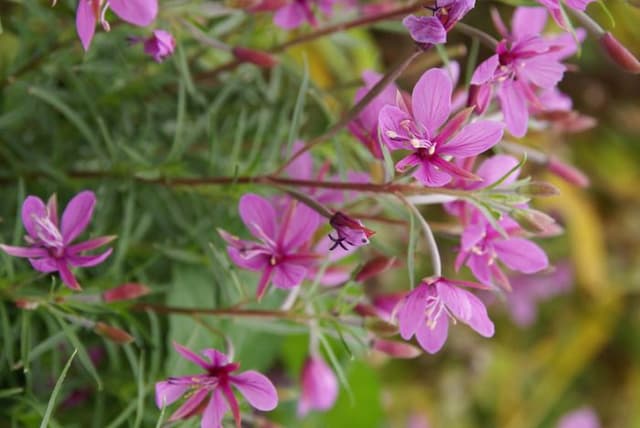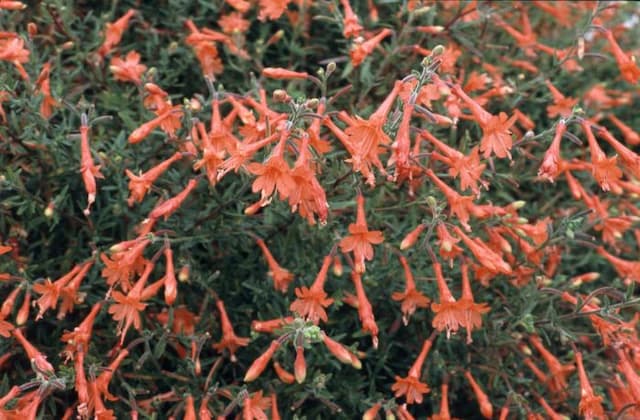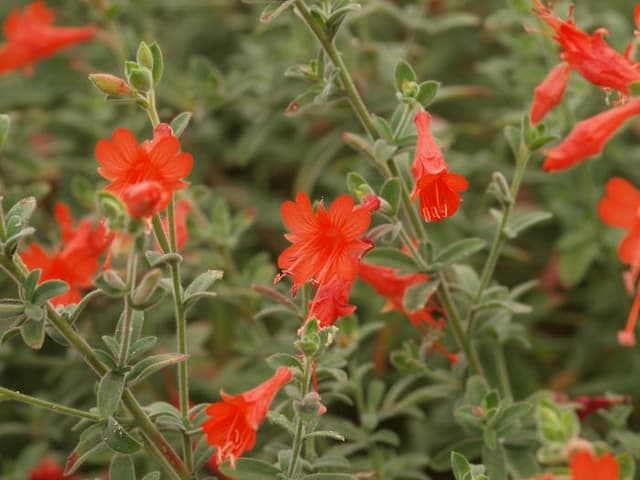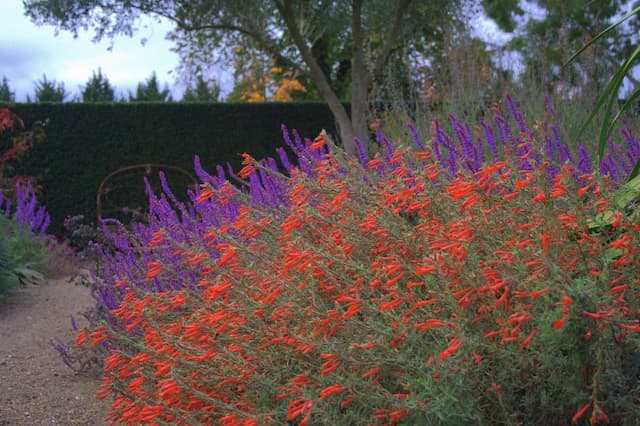Fuchsia Fuchsia 'Empress of Prussia'
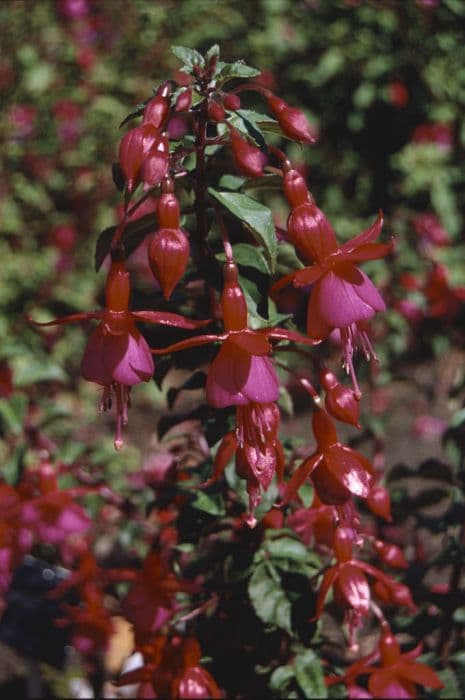
ABOUT
Fuchsia 'Empress of Prussia' is a strikingly ornamental plant known for its distinctive and elegant blooms. The flowers are pendulous, resembling dainty earrings, and display a remarkable blend of colors. Each blossom presents a deep purple to magenta corolla, which is the inner layer of petals, gracefully contrasting with the rich red, elongated sepals – the outer floral leaves that sometimes look like petals themselves. The flowers dangle from the branches, swaying gently in the breeze, and are favored by gardeners for their regal appearance and the way they add a touch of sophistication to the landscape. The foliage of this fuchsia variety is also noteworthy, comprised of ovate leaves with a slight serration at the edges, creating a delicate texture. The leaves are a vibrant green, which creates a lush backdrop for the vivid flowers. The plant tends to have a bushy appearance, with stems that arch elegantly under the weight of the blooms. In summary, Fuchsia 'Empress of Prussia' is a magnificent plant with a royal array of dazzling purple and red flowers, partnered with lush green leaves, contributing to its overall charm and making it a popular choice for adding a burst of color and grace to gardens.
About this plant
 Names
NamesSynonyms
Empress of Prussia Fuchsia, Hardy Fuchsia, Lady's Eardrops
Common names
Fuchsia 'Empress of Prussia'.
 Toxicity
ToxicityTo humans
Fuchsia 'Empress of Prussia', commonly known as Fuchsia, is generally considered non-toxic to humans. There are no well-documented cases of poisoning from ingestion of this plant. Therefore, no symptoms or consequences of poisoning from this plant are expected in humans under normal circumstances.
To pets
For pets, Fuchsia 'Empress of Prussia', commonly referred to as Fuchsia, is also considered non-toxic. It is not known to cause serious illness or symptoms in pets if ingested. However, individual animals might have sensitivities that could lead to mild digestive upset, but this is not typical. There are no established consequences of poisoning from this plant for pets.
 Characteristics
CharacteristicsLife cycle
Perennials
Foliage type
Deciduous
Color of leaves
Green
Flower color
Mixed
Height
1-2 feet (30-61 cm)
Spread
1-2 feet (30-61 cm)
Plant type
Shrub
Hardiness zones
9
Native area
Central America
Benefits
 General Benefits
General Benefits- Ornamental Appeal: The Fuchsia 'Empress of Prussia' is known for its striking appearance with vibrant, pendant-like flowers and lush foliage, which adds visual interest to gardens and landscapes.
- Hummingbird Attractor: The tubular flowers of this variety are attractive to hummingbirds, which are known to pollinate them.
- Shade Tolerant: This plant can thrive in partially shaded environments where other flowering plants might struggle, making it versatile for garden design.
- Container Gardening: Fuchsias are well-suited for growing in containers or hanging baskets, allowing for decorative versatility on patios and balconies.
- Long Blooming Period: Fuchsia 'Empress of Prussia' blooms from late spring through early fall, providing extended color and interest in the garden.
- Easy Pruning: They respond well to pruning, which makes it easy to maintain their size and shape, and encourages more prolific blooming.
- Non-Invasive: Unlike some ornamental species, Fuchsias are not invasive, so they work well alongside other plants without the risk of them taking over.
 Medical Properties
Medical PropertiesThis plant is not used for medical purposes.
 Air-purifying Qualities
Air-purifying QualitiesThis plant is not specifically known for air purifying qualities.
 Other Uses
Other Uses- Hummingbird attractant: Fuchsia 'Empress of Prussia' can be used in gardens to attract hummingbirds, which are drawn to its bright, tubular flowers.
- Photography subject: The vibrant and unique blossoms make this plant an excellent subject for botanical photography and artistic compositions.
- Bonsai: Some gardeners may use Fuchsia 'Empress of Prussia' for bonsai due to its potential for intricate branching and attractive flowers.
- Fairy gardens: Its delicate flowers and shrub-like growth habit make it an enchanting addition to whimsical fairy garden designs.
- Educational tool: The plant can be used in schools or educational programs to teach about plant biology and hybridization, as fuchsias are a popular genus for hybridizing.
- Art inspiration: Artists may draw inspiration from the vivid colors and graceful drooping flowers of this plant for paintings, textiles, and other art forms.
- Theme gardens: Fuchsia 'Empress of Prussia' can contribute to themed garden areas, such as Victorian gardens, where fuchsias were historically popular.
- Culinary garnish: Although typically not consumed, the non-toxic flowers can be used as an ornamental garnish for plating and presentation in high-end culinary dishes.
- Color dye: Historically, some species of fuchsia have been used to create a purple dye, although it is not a common practice today.
- Butterfly gardens: While primarily an attractant for hummingbirds, fuchsia plants can also provide nectar for certain species of butterflies.
Interesting Facts
 Feng Shui
Feng ShuiThe Fuchsia is not used in Feng Shui practice.
 Zodiac Sign Compitability
Zodiac Sign CompitabilityThe Fuchsia is not used in astrology practice.
 Plant Symbolism
Plant Symbolism- Elegance: The Fuchsia plant, with its graceful drooping flowers and striking color combinations, often symbolizes elegance and good taste.
- Confiding Love: In the language of flowers, fuchsia can represent confiding love, making it a beautiful way to express one's trust and emotional intimacy with another.
- Amiability: With its inviting appearance and vivid blossoms, the Fuchsia is occasionally associated with amiability, suggesting a warm, friendly and approachable personality.
- Overflowing Abundance: The prolific blooming nature of Fuchsia can signify an overflowing abundance, whether it be of love, opportunities, or creative ideas.
 Water
WaterFuchsia plants typically require consistent moisture without being waterlogged. It is ideal to water 'Empress of Prussia' fuchsia thoroughly whenever the top inch of soil feels dry to the touch, which could be about once or twice a week depending on the climate and weather conditions. Use lukewarm water and soak the soil until it is damp, not saturated, which may amount to roughly 16 to 32 ounces for a medium-sized pot every watering session. Be cautious to avoid wetting the foliage to prevent fungal diseases. During the growing season, the plant may need more frequent watering, but always check the soil moisture first.
 Light
LightFuchsia 'Empress of Prussia' thrives best in a location that provides morning sunlight and afternoon shade. Too much intense sun can cause scorching, whereas too little light can lead to sparse flowering. The ideal spot would be east or north-facing, where the plant can enjoy bright but indirect light for most of the day. Ensuring proper light conditions will promote healthy growth and abundant blooms.
 Temperature
TemperatureFuchsias prefer a cool to moderate climate and do not fare well in extreme temperatures. For 'Empress of Prussia', the ideal temperature range is between 60°F and 75°F. It can survive minimum temperatures down to about 50°F and maximum temperatures up to about 85°F, beyond which the plant may start showing signs of stress. Fuchsia 'Empress of Prussia' requires protection from both frost and intense summer heat to thrive.
 Pruning
PruningPruning 'Empress of Prussia' fuchsia promotes bushier growth and more flowers. Trim back the tips of the branches in early spring to encourage branching. After the initial spring pruning, occasional pinching of the tips can be done throughout the growing season to maintain shape. Significant pruning should be limited to the early spring before new growth starts, and again after flowering has finished. Removing dead or weak stems is also necessary to improve air circulation and overall health.
 Cleaning
CleaningAs needed
 Soil
SoilFuchsias, including 'Empress of Prussia', thrive in a well-draining, fertile, loamy soil with a pH between 6.0-7.0. A mix containing one part peat moss, one part loam, and one part perlite or sand is ideal. Regular feeding during the growing season will support lush growth.
 Repotting
RepottingFuchsias, like 'Empress of Prussia', should be repotted annually or when the root system outgrows the current container. Best done in late winter or early spring before new growth begins.
 Humidity & Misting
Humidity & MistingFuchsias, such as 'Empress of Prussia', prefer high humidity levels, around 60-70%. Maintaining these humidity levels will help promote healthy growth and abundant flowering.
 Suitable locations
Suitable locationsIndoor
Place in bright, indirect light and maintain high humidity for growth.
Outdoor
Grow in part shade, sheltered from wind, with moist soil.
Hardiness zone
7-10 USDA
 Life cycle
Life cycleThe Fuchsia 'Empress of Prussia', also known as the Fuchsia, begins its life cycle when seeds germinate or cuttings root in moist, well-draining soil. Upon establishment, the seedlings or rooted cuttings enter a vigorous vegetative growth stage, developing a bushy structure with ample leaves. As the plant matures, it enters the flowering stage, producing distinctive pendulous flowers with a combination of purple and pink hues, often blooming from spring until frost. After pollination, the flowers give way to small, edible fruits. In regions with mild climates, the Fuchsia may continue to live as a perennial, going dormant over winter and resuming growth in spring; in colder climates, it is often treated as an annual or overwintered indoors. The plant can be pruned periodically to maintain shape and encourage more prolific blooming in the following season.
 Propogation
PropogationPropogation time
Spring-Early Summer
Propogation: The Fuchsia 'Empress of Prussia', commonly known as fuchsia, is typically propagated through softwood cuttings, and the best time to do this is late spring to early summer when the plant is actively growing. To propagate by cuttings, a healthy, non-flowering shoot is selected and cut to about 2-4 inches (5-10 cm) in length, making sure to include at least two sets of leaves. The bottom set of leaves is removed, and the cut end may be dipped in rooting hormone to enhance root development. The cutting is then planted in a well-draining potting mix, keeping the soil moist but not waterlogged. Within a few weeks, the cutting should develop roots, and it can be transplanted to a permanent location once it has established a good root system.
